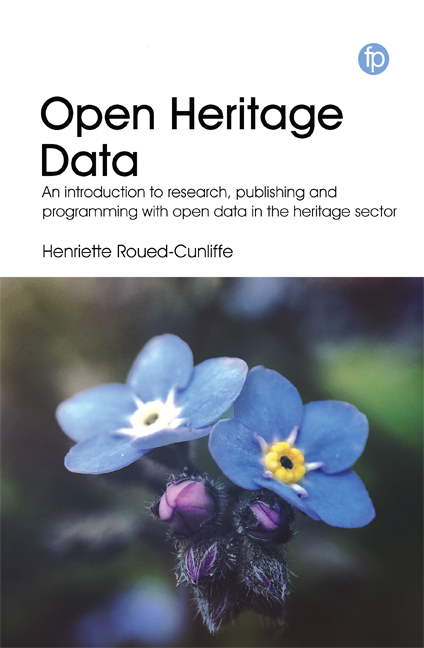 Open Heritage Data
Open Heritage Data Book contents
- Frontmatter
- Dedication
- Contents
- List of Case Studies, Figures and Tables
- List of Abbreviations
- Acknowledgements
- Preface
- Introduction
- 1 Openness in Heritage
- 2 Sharing Legally
- 3 Publishing Open Data
- 4 Using and Reusing Open Data
- 5 Visualising Open Data
- 6 Combining Open Data
- 7 Open Data for Research
- Appendix A Examples Used in the Book
- Appendix B Introduction to Coding
- References
- Index
Preface
Published online by Cambridge University Press: 23 July 2020
- Frontmatter
- Dedication
- Contents
- List of Case Studies, Figures and Tables
- List of Abbreviations
- Acknowledgements
- Preface
- Introduction
- 1 Openness in Heritage
- 2 Sharing Legally
- 3 Publishing Open Data
- 4 Using and Reusing Open Data
- 5 Visualising Open Data
- 6 Combining Open Data
- 7 Open Data for Research
- Appendix A Examples Used in the Book
- Appendix B Introduction to Coding
- References
- Index
Summary
This book has been a long time in the making. My first experience with making heritage more available through the use of digital technology and data was actually rather analogue. In 2002 I spent a year in Hanoi, Vietnam as an au pair for a Danish family. During my free time I volunteered for the Friends of Viet Nam Heritage Project, which aimed to translate the texts and labels in the Museum of Vietnamese History from Vietnamese into French and English. According to a certificate signed by the Director of the Museum (but worded by the project volunteers), I took a widely varied group of translations and codified them in a standard final form for printing for the museum. This sounds quite advanced. In reality, I remember using some version of MS Word to make a numbered diagram of the exhibition case and typed up the translations to match. Nevertheless, it taught me valuable lessons about making digital tools that are useful for their purpose, about the value of including heritage amateurs in the work of institutions, about the importance of sharing heritage data and about not being afraid to work with this digitally.
These lessons have come in handy to me as a student of archaeology, in my work in museums, on excavations and in my research in digital heritage.
When I began to work with open heritage data for my MSc in Archaeological Computing at the University of Southampton, information on data sharing was sparse. I remember the first time I tried to search the web for information on how to implement the Simple Object Access Protocol (SOAP). Having no idea what to search for other than SOAP, I ended up looking at many results for various scented soaps. Coming to this type of coding from a background mainly in the humanities, I had little idea of how to search and find the information I needed in order to get my ‘Heritage Portals and Cross-Border Data Interoperability’ project to work (Roued Olsen, 2007a). I was not even sure what information I needed. This also seems to be the case for most people I know in heritage – students, professionals and amateurs. We rarely have a computer science background and the learning curve can sometimes be so steep that it becomes an impossible challenge.
- Type
- Chapter
- Information
- Open Heritage DataAn Introduction to Research, Publishing and Programming with Open Data in the Heritage Sector, pp. xvii - xviiiPublisher: FacetPrint publication year: 2019
